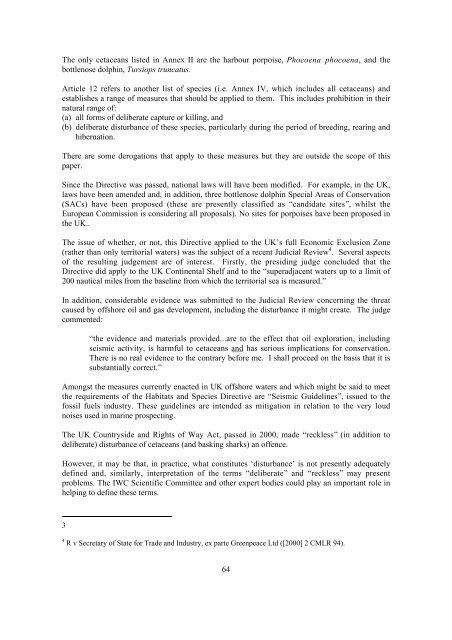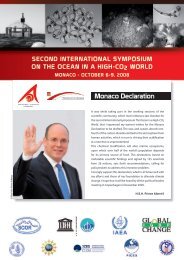Oceans of noise - Whale and Dolphin Conservation Society
Oceans of noise - Whale and Dolphin Conservation Society
Oceans of noise - Whale and Dolphin Conservation Society
- No tags were found...
You also want an ePaper? Increase the reach of your titles
YUMPU automatically turns print PDFs into web optimized ePapers that Google loves.
The only cetaceans listed in Annex II are the harbour porpoise, Phocoena phocoena, <strong>and</strong> thebottlenose dolphin, Tursiops truncatus.Article 12 refers to another list <strong>of</strong> species (i.e. Annex IV, which includes all cetaceans) <strong>and</strong>establishes a range <strong>of</strong> measures that should be applied to them. This includes prohibition in theirnatural range <strong>of</strong>:(a) all forms <strong>of</strong> deliberate capture or killing, <strong>and</strong>(b) deliberate disturbance <strong>of</strong> these species, particularly during the period <strong>of</strong> breeding, rearing <strong>and</strong>hibernation.There are some derogations that apply to these measures but they are outside the scope <strong>of</strong> thispaper.Since the Directive was passed, national laws will have been modified. For example, in the UK,laws have been amended <strong>and</strong>, in addition, three bottlenose dolphin Special Areas <strong>of</strong> <strong>Conservation</strong>(SACs) have been proposed (these are presently classified as “c<strong>and</strong>idate sites”, whilst theEuropean Commission is considering all proposals). No sites for porpoises have been proposed inthe UK..The issue <strong>of</strong> whether, or not, this Directive applied to the UK’s full Economic Exclusion Zone(rather than only territorial waters) was the subject <strong>of</strong> a recent Judicial Review 4 . Several aspects<strong>of</strong> the resulting judgement are <strong>of</strong> interest. Firstly, the presiding judge concluded that theDirective did apply to the UK Continental Shelf <strong>and</strong> to the “superadjacent waters up to a limit <strong>of</strong>200 nautical miles from the baseline from which the territorial sea is measured.”In addition, considerable evidence was submitted to the Judicial Review concerning the threatcaused by <strong>of</strong>fshore oil <strong>and</strong> gas development, including the disturbance it might create. The judgecommented:“the evidence <strong>and</strong> materials provided...are to the effect that oil exploration, includingseismic activity, is harmful to cetaceans <strong>and</strong> has serious implications for conservation.There is no real evidence to the contrary before me. I shall proceed on the basis that it issubstantially correct.”Amongst the measures currently enacted in UK <strong>of</strong>fshore waters <strong>and</strong> which might be said to meetthe requirements <strong>of</strong> the Habitats <strong>and</strong> Species Directive are “Seismic Guidelines”, issued to thefossil fuels industry. These guidelines are intended as mitigation in relation to the very loud<strong>noise</strong>s used in marine prospecting.The UK Countryside <strong>and</strong> Rights <strong>of</strong> Way Act, passed in 2000, made “reckless” (in addition todeliberate) disturbance <strong>of</strong> cetaceans (<strong>and</strong> basking sharks) an <strong>of</strong>fence.However, it may be that, in practice, what constitutes ‘disturbance’ is not presently adequatelydefined <strong>and</strong>, similarly, interpretation <strong>of</strong> the terms “deliberate” <strong>and</strong> “reckless” may presentproblems. The IWC Scientific Committee <strong>and</strong> other expert bodies could play an important role inhelping to define these terms.34 R v Secretary <strong>of</strong> State for Trade <strong>and</strong> Industry, ex parte Greenpeace Ltd ([2000] 2 CMLR 94).64




